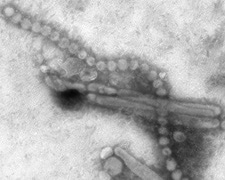Avian Influenza A (H7N9) Virus
Background
Human infections with a new avian influenza A (H7N9) virus (“H7N9”) were first reported in China in March 2013. Annual epidemics of sporadic human infections with H7N9 viruses in China have been reported since that time. Studies indicate that avian influenza A viruses, like seasonal influenza viruses, have a seasonal pattern: they circulate at higher levels in cold weather and at lower levels in warm weather. China is currently experiencing its 5th epidemic of H7N9 human infections. As of January 16, 2017[PDF - 382 KB, 9 pages], cumulative reported human infections with H7N9 virus totaled 918 with 359 deaths. On February 10, 2017, the World Health Organization (WHO) published a scientific analysis of the avian influenza A (H7N9) virus in China during the 5th annual epidemic.
Epidemiology
Most human infections with H7N9 virus have occurred after exposure to poultry; H7N9 viruses continue to circulate in poultry in China. Most reported patients with H7N9 virus infection have had severe respiratory illness (e.g. pneumonia); about 40% of patients have died. Rare instances of limited person-to-person spread of this virus have been identified in China, but there is no evidence of sustained person-to-person spread of H7N9 virus. Some cases of H7N9 have been reported outside of mainland China but most of these infections have occurred among people who had traveled to mainland China before becoming ill. H7N9 viruses have not been detected in people or birds in the United States.
CDC Risk Assessment
While the current risk to the public’s health posed by H7N9 virus is low, the pandemic potential of this virus is concerning. Influenza viruses constantly change and it’s possible that this virus could gain the ability to spread easily and sustainably among people, triggering a global outbreak of disease (pandemic). In fact, of the influenza A viruses that are of special concern to public health, H7N9 virus is rated by the Influenza Risk Assessment Tool (IRAT), as having the greatest potential to cause a pandemic, as well as potentially posing the greatest risk to severely impact public health.
It’s likely that sporadic human infections with H7N9 virus associated with poultry exposure will continue to occur in China. It's also possible that H7N9 virus may spread to poultry in neighboring countries and that human cases associated with poultry exposure may be detected in neighboring countries. It’s also possible that H7N9 cases may continue to be detected among travelers returning from H7N9 virus-affected countries, even possibly in the United States. However, as long as there is no evidence of ongoing, sustained person-to-person spread of H7N9 virus, the public health risk assessment would not change substantially.
CDC Response
The U.S. Government supports international surveillance for H7N9 virus and other influenza A viruses with pandemic potential. CDC is following the H7N9 situation closely and coordinating with domestic and international partners. CDC takes routine preparedness actions whenever a new virus with pandemic potential is identified, including developing candidate vaccine viruses to use for vaccine production in case vaccine is needed. CDC has already developed 3 H7N9 candidate vaccine viruses (CVVs). These remained antigenically like H7N9 viruses that were circulating during the 4th epidemic. Genetic and antigenic analysis of viruses from the 5th epidemic is ongoing at CDC. This includes looking at viruses from the 5th epidemic to consider whether an updated candidate vaccine virus might be needed. CDC also will look at 5th epidemic viruses to see whether these remain susceptible to the antiviral drugs classified as neuraminidase inhibitors. CDC has issued guidance to clinicians and public health authorities in the United States, as well as provided information for people traveling to China. CDC will provide updated information as it becomes available.
Recently Reported
- World Health Organization report: ”Analysis of recent scientific information on avian influenza A(H7N9) virus”
- World Health Organization report: "Influenza at the human-animal interface: summary and assessment, 20 December to 16 January 2017"[328 KB, 9 pages]
- MMWR report: "Assessing Change in Avian Influenza A(H7N9) Virus Infections During the Fourth Epidemic — China, September 2015–August 2016."























.png)











No hay comentarios:
Publicar un comentario